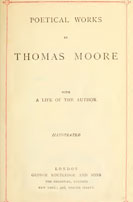Poetical Works
“Then he began to talk of school and and of books. He asked us whether we
had read the poetry of Thomas Moore or the works of Sir Walter Scott and
Lord Lytton. I pretended that I had read every book he mentioned so that in
the end he said:
—Ah, I can see you are a bookworm like myself.”
-“An Encounter” (D 25)
Moore is one of three Romantic writers discussed in “An Encounter,” along with Scott and Lytton, and throughout much of the nineteenth century each was a best-seller. The success of these authors meant that millions of copies of their books flooded the English-speaking world. Moore, Scott, and Lytton, much like Dickens, were household literary names.
The songs of Moore arise time and time again in Joyce’s works, and in “Two Gallants” the harpist on Kildare Street plays “The Song of Fionnuala” from Moore’s Irish Melodies. Joyce owned a copy of Moore’s works published by George Routledge and Sons (JJTL 342).
Copies of Moore’s Melodies could be found Final in sitting rooms across Ireland. Mumford Jones, one of Moore’s biographers, observes that the format and design of the early issues of the Melodies contributed to its wide appeal. He describes,
a tall, thin folio almost fifteen inches high, so bound as to open for the pianofortes of the day; a border of shamrocks and willows running around the gray-green cover, the title a riot of type faces; a rude woodcut (said to have first appeared on a Dublin broadside commemorating Emmet) of the Muse of Ireland, chastely clad, pensively at ease under a willow tree, her right arm negligently resting on a Celtic harp. . . (105)
The format of the edition of Moore’s works owned by Joyce lacks these conscious markers of Irishness, and it is a volume made for the hands of a poetry reader, rather than a piano’s music stand.

